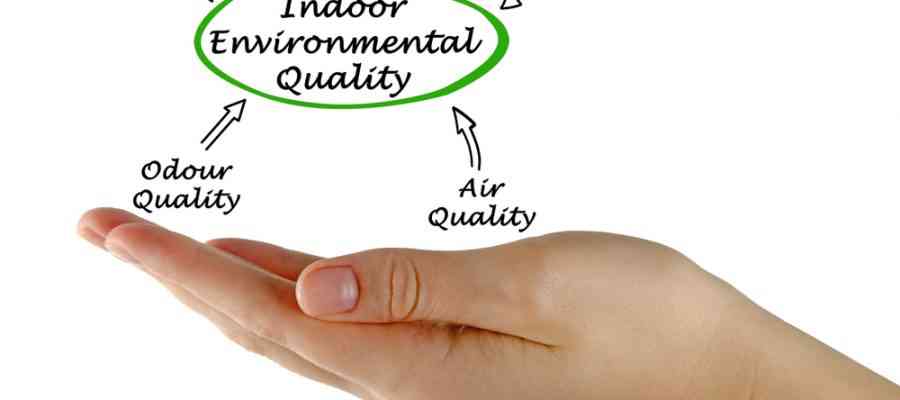We all know that is a well-documented fact that people spend almost 90% of their time indoors – either at home, office, malls or buildings. Therefore, it becomes extremely important to consider not just the air pollution but indoor air pollution as well. In most cases, indoor air pollution should be more important than the outer one. You have already heard about the Indoor Air Quality (IAQ) which comprises of the quality of air inside the buildings that you are breathing. Now another term has come up into the public domain which is Indoor Environmental Quality (IEQ).
IEQ involves a series of complex combinations that include Indoor Air Quality (IAQ), noise disturbance, room temperature, occupant density, indoor lighting, cleanliness and measures aimed at protecting an individual’s mental health. All these factors add up to what we call IEQ and it simply illustrates the importance of building engineering in shaping the health of the occupants living/working inside. There is much more than simply providing clean air inside the buildings for the inhabitants but rather a multitude of factors are involved mentioned above.
Poor IEQ (indoor environmental quality) can be caused by various factors like:
- Molds
- Chemicals present in paints, adhesives, sealants or furniture
- Pollutants from shoes and slippers
- Asbestos
- Poor ventilation
- Extreme temperatures (hot or cold)
- Absence of proper lighting
- Improper cleaning/hygiene
- Poor construction of the building
- Conditions conducive to bacterial growth
- Loud Noise sources
- Smoking inside or near building entrances
- Combustion processes of HVAC, fireplaces and kitchen stoves
- Respiratory processes of the occupants, which release carbon dioxide and other germs
- Moisture
Architects and construction companies have now started to give priority to the IEQ of the building but a large portion of the population is still pretty much ignorant regarding IEQ. Indoor Environmental Quality is especially important for highly sensitive environments like schools, colleges, nursing homes, elderly care centers etc.
Here are some of the symptoms (not limited to) that can arise out of poor indoor environmental quality (IEQ):
- Headache
- Fatigue
- Sneezing
- Cough
- Skin rashes
- Cold
- Nasal congestion
- Dizziness
- Red Eyes
- Irritation of skin, eyes, nose, throat
- Nausea
- Shortness of breath
- Sudden allergies
Poor IEQ conditions may lead to an adverse effect on the cognitive abilities of the brain and might also cause delayed brain development among children.
The best way to prevent indoor pollutants and improve the IEQ is to control the pollutants at their source. The next line of defence would be developing proper ventilation via windows and ventilation ducts. Make sure that your AC Ducts are properly cleaned as well regularly. Here are some of the methods to improve IEQ levels of a building
Contents
Good Design
Architects and engineers need to work on a proper design wherein proper ventilation are given a priority as well as access to direct sunlight and designing of exterior entrances along with regular entryway systems to catch and hold dirt particles. Also designing the HVAC systems so as to isolate kitchen/fireplace operations from the rest of the occupant areas. They also have to ensure that the building materials used in the construction do not use excessive chemicals which are harmful to the residents of the building. Another thing to consider is the growth of molds in the presence of moisture. Steps should be taken to control or eliminate moisture levels as much as possible so that they do not promote ideal breeding grounds for mold, algae, allergens or bacteria inside the building.
Engineers need to appreciate the importance of sunlight and fresh air. Therefore, windows should be provided in all occupied spaces. The windows have to be provided with solar glare control and adjustments to open or close as per the occupants’ desire. All designs need to take the natural light into consideration as well as the location of convenient stairways to encourage inhabitants to use them instead of elevators for health and energy savings.
Designers have to look into EPA recommendations while using construction products like paints, sealants or adhesives. They need to select less hazardous ingredients that are low-emitting.
Temperature
The HVAC system plays an important role in the maintenance of ideal temperature inside modern buildings nowadays. The thermal comfort of the inhabitants needs to be considered as well as understanding moisture dynamics as moisture can promote the growth of bacteria and related allergens inside the living environments. High-performance windows may be employed to increase Mean Radiant Temperature (MRT).
Limit Exposure to Electromagnetic Fields
EMFs (Electromagnetic Fields) are generated by devices creating electrical charges and microwaves, radio and transformers. EMFs are believed to cause cancer, however, the evidence is still insufficient regarding this claim. There are not government recommendations regarding EMFs, but the facility designers and manager should keep this aspect in mind and do some research in dealing with EMF exposure to the inhabitants and try to limit the EMF exposure as much as possible.
Ventilation
I know that we discussed ventilation in the designing aspect of the building, but it is such an important cog in improving IEQ that we need to discuss this separately as well. The ventilation system (which comprises of HVAC, Ducts, Windows, Vents etc) needs to be efficient in terms of energy as well as costs. There has to be a perfect balance between fresh clean air and energy savings when thinking of designing ventilation systems. Indoor Air Quality has to be a topmost priority as the inhabitants spend more than 90% of their time indoors. The key ventilation components have to be protected from contamination and ease of access should be provided for routine inspections and replacements as needed. Incorporating fresh air along with HVAC should be prioritized as well. Vehicle parking lots should be designed so as not to interfere with the indoor air quality of the building and proper distances from the highways should be kept into consideration as well. A proper plan should be developed for regular filter cleaning/replacement in line with a schedule and Duct Cleaning should be a part of the effort to keep the indoor air quality at its optimum levels.
Prevent Growth of Mold & Other pathogens
The building design and HVAC plays a huge role in the growth of mold and fungi. A proper HVAC system should be able to control humidity and temperature irrespective of outside conditions. Dehumidifiers are not just a luxury anymore but rather a necessity now. Designers should carefully consider the envelope of the building to prevent moisture infiltration which might lead to mold, fungi, leakage etc. Regular tests should be done to monitor the air quality inside and outside the building and proper maintenance procedures should be undertaken to prevent infections.
The public restroom can be a source of moisture inside the buildings. Therefore, steps should be taken to make sure that the humidity is under control in these parts of the building.
Lighting
Day-lighting should be an important aspect of any building design as it not just provides access to a great source of light but also reduces energy consumption. Natural light should be integrated with high-performance artificial lights like bulbs, tubes etc. Dark color should be avoided on the walls to maximize natural light reflection and minimize glare. Creation of safer environments should be prioritized for people with low vision.
Water Quality
Water storage systems should be properly sealed and maintained as per recommendations. The water temperatures should be kept at optimum levels so as to avoid the growth of legionellae and related pathogens. Frequent water quality checks should be undertaken so as to maintain the quality of the supply water. Water tank cleaning should also be done at least on a yearly basis so as to keep clean water supply all year round.
Noise
Another important aspect to consider in maintaining ideal IEQ inside the buildings is Noise. The design of the building should be so as to minimize the noise levels entering living spaces from outside. The walls may have some kind of noise cancellation and the design should promote optimum noise levels.
As you can see that IEQ is a very important factor now for the inhabitants of a building. It helps people live a healthy life and also helps in great energy savings as well as cost savings. It is high time that buildings start incorporating Indoor Environmental Quality into their designs as soon as possible.
Sources: Whole Building Design Guide


